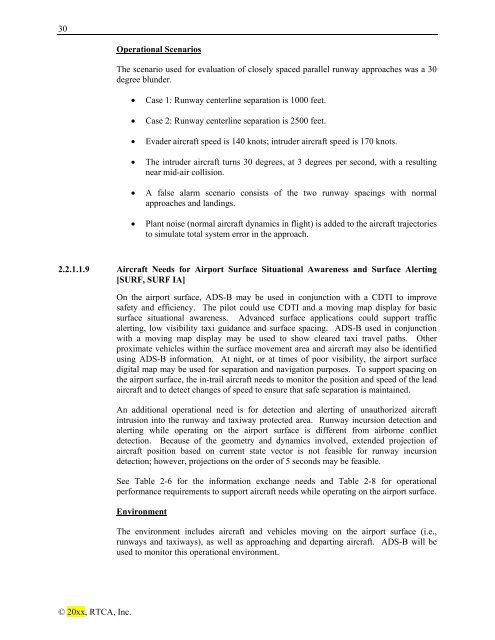Minimum Aviation System Performance Standards for Aircraft ...
Minimum Aviation System Performance Standards for Aircraft ...
Minimum Aviation System Performance Standards for Aircraft ...
Create successful ePaper yourself
Turn your PDF publications into a flip-book with our unique Google optimized e-Paper software.
30<br />
Operational Scenarios<br />
The scenario used <strong>for</strong> evaluation of closely spaced parallel runway approaches was a 30<br />
degree blunder.<br />
� Case 1: Runway centerline separation is 1000 feet.<br />
� Case 2: Runway centerline separation is 2500 feet.<br />
� Evader aircraft speed is 140 knots; intruder aircraft speed is 170 knots.<br />
� The intruder aircraft turns 30 degrees, at 3 degrees per second, with a resulting<br />
near mid-air collision.<br />
� A false alarm scenario consists of the two runway spacings with normal<br />
approaches and landings.<br />
� Plant noise (normal aircraft dynamics in flight) is added to the aircraft trajectories<br />
to simulate total system error in the approach.<br />
2.2.1.1.9 <strong>Aircraft</strong> Needs <strong>for</strong> Airport Surface Situational Awareness and Surface Alerting<br />
[SURF, SURF IA]<br />
© 20xx, RTCA, Inc.<br />
On the airport surface, ADS-B may be used in conjunction with a CDTI to improve<br />
safety and efficiency. The pilot could use CDTI and a moving map display <strong>for</strong> basic<br />
surface situational awareness. Advanced surface applications could support traffic<br />
alerting, low visibility taxi guidance and surface spacing. ADS-B used in conjunction<br />
with a moving map display may be used to show cleared taxi travel paths. Other<br />
proximate vehicles within the surface movement area and aircraft may also be identified<br />
using ADS-B in<strong>for</strong>mation. At night, or at times of poor visibility, the airport surface<br />
digital map may be used <strong>for</strong> separation and navigation purposes. To support spacing on<br />
the airport surface, the in-trail aircraft needs to monitor the position and speed of the lead<br />
aircraft and to detect changes of speed to ensure that safe separation is maintained.<br />
An additional operational need is <strong>for</strong> detection and alerting of unauthorized aircraft<br />
intrusion into the runway and taxiway protected area. Runway incursion detection and<br />
alerting while operating on the airport surface is different from airborne conflict<br />
detection. Because of the geometry and dynamics involved, extended projection of<br />
aircraft position based on current state vector is not feasible <strong>for</strong> runway incursion<br />
detection; however, projections on the order of 5 seconds may be feasible.<br />
See Table 2-6 <strong>for</strong> the in<strong>for</strong>mation exchange needs and Table 2-8 <strong>for</strong> operational<br />
per<strong>for</strong>mance requirements to support aircraft needs while operating on the airport surface.<br />
Environment<br />
The environment includes aircraft and vehicles moving on the airport surface (i.e.,<br />
runways and taxiways), as well as approaching and departing aircraft. ADS-B will be<br />
used to monitor this operational environment.

















